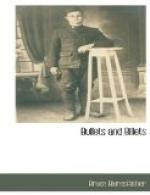Materials were: A bottle of Indian ink, a couple of brushes, about a hundredweight of useless charcoal, and a G.S. blue and red pencil.
Amongst the rough sketches that I did that day were the original drawings for two subsequent “Fragments” of mine.
One was the rough idea for “They’ve evidently seen me,” and the other was “My dream for years to come.” The idea for “They’ve evidently seen me” came whilst carrying back that table to St. Yvon, as I mentioned in a previous chapter, but the scenario for the idea was not provided for until I went to this farm some time later. In intervals of working at the walls I rambled about the farm building, and went up into a loft over a barn at the end of the farm nearest the trenches. I looked out through a hole in the tiles just in time to hear a shell come over from away back amongst the Germans somewhere, and land about five hundred yards to the left. The sentence, “They’ve evidently seen me,” came flashing across my mind again, and I now saw the correct setting in my mind: i.e., the enthusiastic observer looking out of the top of a narrow chimney, whilst a remarkably well-aimed shell leads “him of the binoculars” to suppose that they have seen him.
I came downstairs and made a pencil sketch of my idea, and before I left the trenches that time I had done a wash drawing and sent it to England. This was my second “Fragment.”
The other sketch, “My dream for years to come,” was drawn on one wall of a small apple or potato room, opening off our big room, and the drawing occupied the whole wall.
[Illustration: porters]
I knocked off drawing about four o’clock, and did a little of the alternative occupation, that of looking out through the cracked windows on to the mutilated courtyard in front. It was getting darker now, and nearing the time when I had to put on all my tackle, and gird myself up for my round of the trenches. As soon as it was nearly dark I started out. The other officers generally left a bit later, but as I had such a long way to go, and as I wanted to examine the country while there was yet a little light, I started at dusk. Not yet knowing exactly how much the enemy could see on the open mud flat, I determined to go along by the river bank, and by keeping among the trees I hoped to escape observation. I made for the Douve, and soon got along as far as the row of farms. I explored all these, and a shocking sight they were. All charred and ruined, and the skeleton remains slowly decomposing away into the unwholesome ground about them. I went inside several of the dismantled rooms. Nearly all contained old and battered bits of soldiers’ equipment, empty tins, and remnants of Belgian property. Sad relics of former billeting: a living reminder of the rough times that had preceded our arrival in this locality. I passed on to another farm, and entered the yard near the river. It was nearly full of black wooden crosses, roughly made and painted over with tar. All that was left to mark the graves of those who had died to get our trenches where they were—at the bottom of the Messines ridge. A bleak and sombre winter’s night, that courtyard of the ruined farm, the rows of crosses—I often think of it all now.




